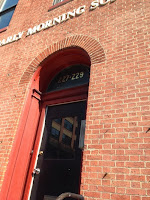 |
| Adam Horn (1792-1843) NYC (Staten Island) and Baltimore Serial "Hatchet Killer" |
Over the last two centuries, whether their ghostly spirits have remained nearby or moved on to more temperate climates, what is fact is that Baltimoreans have been unearthing skeletal remains with surprising frequency. Slightly more bizarre are the locations where these discoveries have been made - backyards, construction sites, and the basements and closets of Baltimore homes.
In many cases, urbanization has encountered the city's old or forgotten cemeteries or private burial sites and in earlier times often trumped their preservation only to result in the relocation of what was supposed to have been final internments. For those that believe that ghostly paranormal activities and hauntings are the result of the departed whose eternal rest had been disturbed, be forewarned of the following locations - they may just be the grounds under which you live, work, or walk.
 |
| Northwestern District Police Station - Corner Penna Ave and Lambert St (Photo: Courtesy, Kildruffs.com) |
Corner of Broadway and Monument Streets (currently bounded on 3 corners by Johns Hopkins University Hospital and Mama Mia's Restaurant and Carry Out on the other) - A Baltimore Sun article from April 1860 eerily described one such event when workmen were laboring for weeks to remove a graveyard and the "disgusting spectacle of exhumed decayed remains has been presented to the gaze of the passer-by...the skull of a human being, evidently a female, with long hair flowing from the bone, was exhumed and exposed to the gaze of the public...It is a shame that such things should be.
Corner of Pennsylvania Avenue and Lambert street (currently a playground) - In April 1873, according to an article in The Sun, workmen engaged in excavating the site where the North-western district police station was being built came across a skeleton from a grave when it was formerly a graveyard.
 |
| Old Cemetery Closure - Baltimore Sun (Notice of April 1873) |
In a lot on the 1900 block of McCulloh Street (currently homes between Robert and Presstman Streets) which was formerly the burial place of St. Alphonsus's Church, in April 1881 a Sun article reported a man was engaged in digging to get brick off his lot when he came upon a vault containing a coffin containing human remains. "The man on discovering the skeleton dropped his tools and fled" before the police were called and properly secured the premises. It is said that the celebrated Andrew Hellman (aka Adam Horn), a NYC and Baltimore famous cold-blooded hatchet and ax serial killer of the 1840s, was buried in this long forgotten cemetery location.
149 North Calvert Street (current location of the Baltimore City Circuit Courthouse) - In July 1883, the bones of an infant were found in a box under the back of a building as reported by The Sun.
In a Canton lot between Boston, Clinton and Tome Streets, was excavated the skeleton of a human person buried in an upright position about three feet from the surface. According to a May 1895 Sun news article, the skeleton was that of a body placed in a box and buried on what was the Philadelphia, Wilmington and Baltimore Railroad Company.
 |
| SW Corner Pleasant St and Courtland St) (Photo: Courtesy MD Hist. Society) |
432 West Pratt (currently the Baltimore Marriott Inner Harbor at Camden Yards) - Found beneath the kitchen in a home at this location was a four and one-half square foot vault built of bricks containing the full skeleton of a man, according to a July 1897 Baltimore Sun account.
Southwest corner of Courtland (currently St. Paul) and Pleasant Streets (near the location of Mercy Hospital) - Likely to have been what remained of an earlier horrible murder was the skeleton of a full-grown man in a coffin located between the ceiling and the roof of the old one-story building. It was reported by The Sun as found by a carpenter in November 1904 shortly before the referenced photograph.
 |
| The Biltmore, Corner Fayette and Paca Sts (Photo: Courtesy, Kildruffs.com) |
Biltmore Hotel (once at the corner of Fayette and Paca Streets) - In March 1955, a skeleton was
reported in The Sun as being found by perplexed hotel employees in the closet of a room at the Biltmore Hotel. The 6-foot set of bones had been reported as missing by the 104th Medical Regiment Armory for 19 days but, after two Chicago truck drivers had occupied the room and checked out, it was now suddenly found. The incident ended when two Armory men retrieved it and, with one holding the head and another its feet, marching the wayward skeleton back along Fayette street to its original resting place.
(Note: Article sources are courtesy of The Baltimore Sun.)





